Spring简介
Spring概述
官网地址:https://spring.io/
-
Spring 是最受欢迎的企业级 Java 应用程序开发框架,数以百万的来自世界各地的开发人员使用Spring 框架来创建性能好、易于测试、可重用的代码。
-
Spring 框架是一个开源的 Java 平台,它最初是由 Rod Johnson 编写的,并且于 2003 年 6 月首次在 Apache 2.0 许可下发布。
-
Spring 是轻量级的框架,其基础版本只有 2 MB 左右的大小。
-
Spring 框架的核心特性是可以用于开发任何 Java 应用程序,但是在 Java EE 平台上构建 web 应用程序是需要扩展的。 Spring 框架的目标是使 J2EE 开发变得更容易使用,通过启用基于 POJO编程模型来促进良好的编程实践。
J2EE了解
-
从整体上讲,J2EE 是使用 Java 技术开发企业级应用的工业标准,它是 Java 技术不断适应和促进企业级应用过程中的产物。
-
适用于企业级应用的 J2EE,提供一个平台独立的、可移植的、多用户的、安全的和基于标准的企业级平台,从而简化企业应用开发、管理和部署。
-
J2EE 是一个标准,而不是一个现成的产品。
Spring家族
项目列表:https://spring.io/projects
我们首先需要了解的是Spring Framework
Spring Framework是Spring 基础框架,可以视为 Spring 基础设施,基本上任何其他 Spring 项目都是以 Spring Framework为基础的。
Spring Framework特性:
-
非侵入式:使用 Spring Framework 开发应用程序时,Spring 对应用程序本身的结构影响非常小。对领域模型可以做到零污染;对功能性组件也只需要使用几个简单的注解进行标记,完全不会破坏原有结构,反而能将组件结构进一步简化。这就使得基于 Spring Framework 开发应用程序时结构清晰、简洁优雅。
-
控制反转:IOC——Inversion of Control,翻转资源获取方向。把自己创建资源、向环境索取资源变成环境将资源准备好,我们享受资源注入。
-
面向切面编程:AOP——Aspect Oriented Programming,在不修改源代码的基础上增强代码功能。
-
容器:Spring IOC 是一个容器,因为它包含并且管理组件对象的生命周期。组件享受到了容器化的管理,替程序员屏蔽了组件创建过程中的大量细节,极大的降低了使用门槛,大幅度提高了开发
效率。 -
组件化:Spring 实现了使用简单的组件配置组合成一个复杂的应用。在 Spring 中可以使用 XML和 Java 注解组合这些对象。这使得我们可以基于一个个功能明确、边界清晰的组件有条不紊的搭
建超大型复杂应用系统。 -
声明式:很多以前需要编写代码才能实现的功能,现在只需要声明需求即可由框架代为实现。
-
一站式:在 IOC 和 AOP 的基础上可以整合各种企业应用的开源框架和优秀的第三方类库。而且Spring 旗下的项目已经覆盖了广泛领域,很多方面的功能性需求可以在 Spring Framework 的基
础上全部使用 Spring 来实现。
Spring Framework五大功能模块
| 功能模块 | 功能介绍 |
|---|---|
| Core Container | 核心容器,在 Spring 环境下使用任何功能都必须基于 IOC 容器。 |
| AOP&Aspects | 面向切面编程 |
| Testing | 提供了对 junit 或 TestNG 测试框架的整合。 |
| Data Access/Integration | 提供了对数据访问/集成的功能。 |
| Spring MVC | 提供了面向Web应用程序的集成功能。 |
IOC
IOC容器
IOC思想
- IOC:Inversion of Control,翻译过来是反转控制。
①获取资源的传统方式
-
自己做饭:买菜、洗菜、择菜、改刀、炒菜,全过程参与,费时费力,必须清楚了解资源创建整个过程中的全部细节且熟练掌握。
-
在应用程序中的组件需要获取资源时,传统的方式是组件主动的从容器中获取所需要的资源,在这样的模式下开发人员往往需要知道在具体容器中特定资源的获取方式,增加了学习成本,同时降低了开发效率。
②反转控制方式获取资源
-
点外卖:下单、等、吃,省时省力,不必关心资源创建过程的所有细节。
-
反转控制的思想完全颠覆了应用程序组件获取资源的传统方式:反转了资源的获取方向——改由容器主动的将资源推送给需要的组件,开发人员不需要知道容器是如何创建资源对象的,只需要提供接收资源的方式即可,极大的降低了学习成本,提高了开发的效率。这种行为也称为查找的被动形式。
③DI
-
DI:Dependency Injection,翻译过来是依赖注入。
-
DI 是 IOC 的另一种表述方式:即组件以一些预先定义好的方式(例如:setter 方法)接受来自于容器的资源注入。相对于IOC而言,这种表述更直接。
所以结论是:IOC 就是一种反转控制的思想,而 DI 是对 IOC 的一种具体实现。
IOC容器在Spring中的实现
-
Spring 的 IOC 容器就是 IOC 思想的一个落地的产品实现。
-
IOC 容器中管理的组件也叫做 bean。
-
在创建 bean 之前,首先需要创建 IOC 容器。Spring 提供了 IOC 容器的两种实现方式:
①BeanFactory
- 这是 IOC 容器的基本实现,是 Spring 内部使用的接口。面向 Spring 本身,不提供给开发人员使用。
②ApplicationContext
- BeanFactory 的子接口,提供了更多高级特性。面向 Spring 的使用者,几乎所有场合都使用 ApplicationContext 而不是底层的 BeanFactory。
ApplicationContext的主要实现类
| 类型名 | 简介 |
|---|---|
| ClassPathXmlApplicationContext | 通过读取类路径下的 XML 格式的配置文件创建 IOC 容器对象 |
| FileSystemXmlApplicationContext | 通过文件系统路径读取 XML 格式的配置文件创建 IOC 容器对象 |
| ConfigurableApplicationContext | ApplicationContext 的子接口,包含一些扩展方法refresh() 和 close(),让 ApplicationContext 具有启动、关闭和刷新上下文的能力。 |
| WebApplicationContext | 专门为 Web 应用准备,基于 Web 环境创建 IOC 容器对象,并将对象引入存入 ServletContext 域中。 |
ClassPathXmlApplicationContext和FileSystemXmlApplicationContext的使用
ApplicationContext ioc= new ClassPathXmlApplicationContext("Spring xml配置文件");
ApplicationContext ioc= new FileSystemXmlApplicationContext("绝对路径");
区别
-
ClassPathXmlApplicationContext 默认会去 classPath 路径下找。classPath 路径指的就是编译后的 classes 目录。
-
而FileSystemXmlApplicationContext是在电脑中的磁盘中寻找
但如果我们的项目在别的电脑上使用时,别人磁盘上不一定有该绝对路径对应的Spring文件,所以,我们一般用使用 ClassPathXmlApplicationContext
基于XML管理bean
入门操作
①我们需要引入相关依赖
<dependencies>
<!-- 基于Maven依赖传递性,导入spring-context依赖即可导入当前所需所有jar包 -->
<dependency>
<groupId>org.springframework</groupId>
<artifactId>spring-context</artifactId>
<version>5.3.3</version>
</dependency>
<!-- junit测试 -->
<dependency>
<groupId>junit</groupId>
<artifactId>junit</artifactId>
<version>4.12</version>
<scope>test</scope>
</dependency>
</dependencies>
基于Maven依赖传递性,导入spring-context依赖即可导入当前所需所有jar包

Maven 的传递性依赖指的是依赖关系之间的继承关系。当项目依赖于 A,而 A 依赖于 B,那么项目也会继承 B 的依赖关系。在 Maven 中,传递性依赖是默认开启的,也就是说,Maven 会自动处理传递性依赖。
②创建类HelloWorld
public class HelloWorld {
public void sayHello(){
System.out.println("helloworld");
}
}
③Spring xml配置文件的创建

④在Spring的配置文件中配置bean
<!--
配置HelloWorld所对应的bean,即将HelloWorld的对象交给Spring的IOC容器管理
通过bean标签配置IOC容器所管理的bean
属性:
id:设置bean的唯一标识
class:设置bean所对应类型的全类名
-->
<bean id="helloworld" class="com.atguigu.spring.bean.HelloWorld"></bean>
⑤创建测试类测试
@Test
public void testHelloWorld(){
ApplicationContext ioc= new ClassPathXmlApplicationContext("applicationContext.xml");
HelloWorld helloworld = (HelloWorld) ioc.getBean("helloworld");
helloworld.sayHello();
}
创建流程(思路)
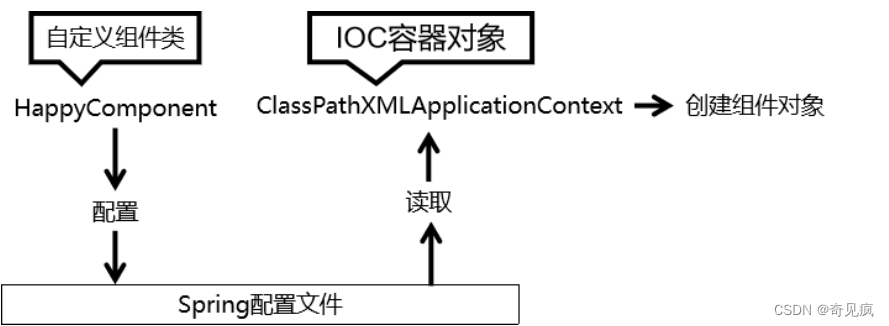
注意
Spring 底层默认通过反射技术调用组件类的无参构造器来创建组件对象,这一点需要注意。如果在需要无参构造器时,没有无参构造器,则会抛出下面的异常:
org.springframework.beans.factory.BeanCreationException: Error creating bean with name
‘helloworld’ defined in class path resource [applicationContext.xml]: Instantiation of bean
failed; nested exception is org.springframework.beans.BeanInstantiationException: Failed
to instantiate [com.atguigu.spring.bean.HelloWorld]: No default constructor found; nested
exception is java.lang.NoSuchMethodException: com.atguigu.spring.bean.HelloWorld.< init >()
获取bean的三种方式
①方式一:根据id获取
- 由于 id 属性指定了 bean 的唯一标识,所以根据 bean 标签的 id 属性可以精确获取到一个组件对象。
上个实验中我们使用的就是这种方式。
HelloWorld helloworld = (HelloWorld) ioc.getBean("helloworld");
②方式二:根据类型获取
HelloWorld bean = ioc.getBean(HelloWorld.class);
③方式三:根据id和类型
HelloWorld bean = ioc.getBean("helloworld", HelloWorld.class);
注意
当根据类型获取bean(第二种方式)时,要求IOC容器中指定类型的bean有且只能有一个
若IOC容器中一个也没有配置
根据类型获取时会抛出异常:NoSuchBeanDefinitionException
org.springframework.beans.factory.NoSuchBeanDefinitionException: No
qualifying bean of type ‘com.atguigu.spring.pojo.HelloWorld’ available
若IOC容器中一共配置了两个:
<bean id="helloworldOne" class="com.atguigu.spring.bean.HelloWorld"></bean>
<bean id="helloworldTwo" class="com.atguigu.spring.bean.HelloWorld"></bean>
根据类型获取时会抛出异常:NoUniqueBeanDefinitionException
org.springframework.beans.factory.NoUniqueBeanDefinitionException: No qualifying bean
of type ‘com.atguigu.spring.bean.HelloWorld’ available: expected single matching bean but
found 2: helloworldOne,helloworldTwo
扩展
如果组件类实现了接口,根据接口类型可以获取 bean 吗?
- 可以,前提是bean唯一
如果一个接口有多个实现类,这些实现类都配置了 bean,根据接口类型可以获取 bean 吗?
- 不行,因为bean不唯一
结论
- 根据类型来获取bean时,在满足bean唯一性的前提下,其实只是看:『对象 instanceof 指定的类型』的返回结果,只要返回的是true就可以认定为和类型匹配,能够获取到。
依赖注入
依赖注入之setter注入
我们创建一个Student并写几个成员变量并提供对应的get set 方法
public class Student {
private Integer id;
private String name;
private Integer age;
private String sex;
public Student() {
}
public Integer getId() {
return id;
}
public void setId(Integer id) {
this.id = id;
}
public String getName() {
return name;
}
public void setName(String name) {
this.name = name;
}
public Integer getAge() {
return age;
}
public void setAge(Integer age) {
this.age = age;
}
public String getSex() {
return sex;
}
public void setSex(String sex) {
this.sex = sex;
}
@Override
public String toString() {
return "Student{" +
"id=" + id +
", name='" + name + '\'' +
", age=" + age +
", sex='" + sex + '\'' +
'}';
}
}
配置bean时为属性赋值
<bean id="studentOne" class="com.atguigu.spring.bean.Student">
<!-- property标签:通过组件类的setXxx()方法给组件对象设置属性 -->
<!-- name属性:指定属性名(这个属性名是getXxx()、setXxx()方法定义的,和成员变量无关)
-->
<!-- value属性:指定属性值 -->
<property name="id" value="1001"></property>
<property name="name" value="张三"></property>
<property name="age" value="23"></property>
<property name="sex" value="男"></property>
</bean>
依赖注入之构造器注入
在Student类中添加有参构造
public Student(Integer id, String name, Integer age, String sex) {
this.id = id;
this.name = name;
this.age = age;
this.sex = sex;
}
配置bean
<bean id="studentTwo" class="com.atguigu.spring.bean.Student">
<constructor-arg value="1002"></constructor-arg>
<constructor-arg value="李四"></constructor-arg>
<constructor-arg value="33"></constructor-arg>
<constructor-arg value="女"></constructor-arg>
</bean>
注意
constructor-arg标签还有两个属性可以进一步描述构造器参数:
index属性:指定参数所在位置的索引(从0开始)
name属性:指定参数名
特殊值处理
①字面量赋值
什么是字面量?
如
int a = 10;
-
声明一个变量a,初始化为10,此时a就不代表字母a了,而是作为一个变量的名字。当我们引用a的时候,我们实际上拿到的值是10。
-
而如果a是带引号的:‘a’,那么它现在不是一个变量,它就是代表a这个字母本身,这就是字面量。
所以字面量没有引申含义,就是我们看到的这个数据本身。
<!-- 使用value属性给bean的属性赋值时,Spring会把value属性的值看做字面量 -->
<property name="name" value="张三"/>
②null值
<property name="name">
<null />
</property>
注意:
<property name="name" value="null"></property>
以上写法,为name所赋的值是字符串null
③xml实体
<!-- 小于号在XML文档中用来定义标签的开始,不能随便使用,如a<b -->
<!-- 解决方案一:使用XML实体来代替 -->
<property name="expression" value="a < b"/>
④CDATA节
<property name="expression">
<!-- 解决方案二:使用CDATA节 -->
<!-- CDATA中的C代表Character,是文本、字符的含义,CDATA就表示纯文本数据 -->
<!-- XML解析器看到CDATA节就知道这里是纯文本,就不会当作XML标签或属性来解析 -->
<!-- 所以CDATA节中写什么符号都随意 -->
<value><![CDATA[a < b]]></value>
</property>
为类类型属性赋值
准备工作
我们先创建一个班级类Clazz便于测试
public class Clazz {
private Integer clazzId;
private String clazzName;
public Integer getClazzId() {
return clazzId;
}
public void setClazzId(Integer clazzId) {
this.clazzId = clazzId;
}
public String getClazzName() {
return clazzName;
}
public void setClazzName(String clazzName) {
this.clazzName = clazzName;
}
@Override
public String toString() {
return "Clazz{" +
"clazzId=" + clazzId +
", clazzName='" + clazzName + '\'' +
'}';
}
public Clazz() {
}
public Clazz(Integer clazzId, String clazzName) {
this.clazzId = clazzId;
this.clazzName = clazzName;
}
}
在上面Student类中添加以下代码
private Clazz clazz;
public Clazz getClazz() {
return clazz;
}
public void setClazz(Clazz clazz) {
this.clazz = clazz;
}
为类类型属性赋值有三种方式
方式一:引用外部已声明的bean
配置Clazz类型的bean:
<bean id="clazzOne" class="com.atguigu.spring.bean.Clazz">
<property name="clazzId" value="1111"></property>
<property name="clazzName" value="财源滚滚班"></property>
</bean>
为Student中的clazz属性赋值:
<bean id="studentFour" class="com.atguigu.spring.bean.Student">
<property name="id" value="1004"></property>
<property name="name" value="赵六"></property>
<property name="age" value="26"></property>
<property name="sex" value="女"></property>
<!-- ref属性:引用IOC容器中某个bean的id,将所对应的bean为属性赋值 -->
<property name="clazz" ref="clazzOne"></property>
</bean>
如果错把ref属性写成了value属性,会抛出异常:
Caused by: java.lang.IllegalStateException: Cannot convert value of
type ‘java.lang.String’ to required type
‘com.atguigu.spring.bean.Clazz’ for property ‘clazz’: no matching
editors or conversion strategy found
意思是不能把String类型转换成我们要的Clazz类型,说明我们使用value属性时,Spring只把这个属性看做一个普通的字符串,不会认为这是一个bean的id,更不会根据它去找到bean来赋值
方式二:内部bean
<bean id="studentFour" class="com.atguigu.spring.bean.Student">
<property name="id" value="1004"></property>
<property name="name" value="赵六"></property>
<property name="age" value="26"></property>
<property name="sex" value="女"></property>
<property name="clazz">
<!-- 在一个bean中再声明一个bean就是内部bean -->
<!-- 内部bean只能用于给属性赋值,不能在外部通过IOC容器获取,因此可以省略id属性 -->
<bean id="clazzInner" class="com.atguigu.spring.bean.Clazz">
<property name="clazzId" value="2222"></property>
<property name="clazzName" value="远大前程班"></property>
</bean>
</property>
</bean>
③方式三:级联属性赋值
注意
- 一定先引用某个bean为属性赋值,才可以使用级联方式更新属性
<bean id="studentFour" class="com.atguigu.spring.bean.Student">
<property name="id" value="1004"></property>
<property name="name" value="赵六"></property>
<property name="age" value="26"></property>
<property name="sex" value="女"></property>
<!-- 一定先引用某个bean为属性赋值,才可以使用级联方式更新属性 -->
<property name="clazz" ref="clazzOne"></property>
<property name="clazz.clazzId" value="3333"></property>
<property name="clazz.clazzName" value="最强王者班"></property>
</bean>
为数组类型属性赋值
准备工作
在Student类中添加以下代码:
private String[] hobbies;
public String[] getHobbies() {
return hobbies;
}
public void setHobbies(String[] hobbies) {
this.hobbies = hobbies;
}
配置bean
<bean id="studentFour" class="com.atguigu.spring.bean.Student">
<property name="id" value="1004"></property>
<property name="name" value="赵六"></property>
<property name="age" value="26"></property>
<property name="sex" value="女"></property>
<!-- ref属性:引用IOC容器中某个bean的id,将所对应的bean为属性赋值 -->
<property name="clazz" ref="clazzOne"></property>
<property name="hobbies">
<array>
<value>抽烟</value>
<value>喝酒</value>
<value>烫头</value>
</array>
</property>
</bean>
为集合类型属性赋值
为List集合类型属性赋值
在Clazz类中添加以下代码:
private List<Student> students;
public List<Student> getStudents() {
return students;
}
public void setStudents(List<Student> students) {
this.students = students;
}
配置bean
<bean id="clazzTwo" class="com.atguigu.spring.bean.Clazz">
<property name="clazzId" value="4444"></property>
<property name="clazzName" value="Javaee0222"></property>
<property name="students">
<list>
<ref bean="studentOne"></ref>
<ref bean="studentTwo"></ref>
<ref bean="studentThree"></ref>
</list>
</property>
</bean>
若为Set集合类型属性赋值,只需要将其中的list标签改为set标签即可
为Map集合类型属性赋值
准备工作
创建教师类Teacher:
public class Teacher {
private Integer teacherId;
private String teacherName;
public Integer getTeacherId() {
return teacherId;
}
public void setTeacherId(Integer teacherId) {
this.teacherId = teacherId;
}
public String getTeacherName() {
return teacherName;
}
public void setTeacherName(String teacherName) {
this.teacherName = teacherName;
}
public Teacher(Integer teacherId, String teacherName) {
this.teacherId = teacherId;
this.teacherName = teacherName;
}
public Teacher() {
}
@Override
public String toString() {
return "Teacher{" +
"teacherId=" + teacherId +
", teacherName='" + teacherName + '\'' +
'}';
}
}
在Student类中添加以下代码:
private Map<String, Teacher> teacherMap;
public Map<String, Teacher> getTeacherMap() {
return teacherMap;
}
public void setTeacherMap(Map<String, Teacher> teacherMap) {
this.teacherMap = teacherMap;
}
配置bean:
<bean id="teacherOne" class="com.atguigu.spring.bean.Teacher">
<property name="teacherId" value="10010"></property>
<property name="teacherName" value="大宝"></property>
</bean>
<bean id="teacherTwo" class="com.atguigu.spring.bean.Teacher">
<property name="teacherId" value="10086"></property>
<property name="teacherName" value="二宝"></property>
</bean>
<bean id="studentFour" class="com.atguigu.spring.bean.Student">
<property name="id" value="1004"></property>
<property name="name" value="赵六"></property>
<property name="age" value="26"></property>
<property name="sex" value="女"></property>
<!-- ref属性:引用IOC容器中某个bean的id,将所对应的bean为属性赋值 -->
<property name="clazz" ref="clazzOne"></property>
<property name="hobbies">
<array>
<value>抽烟</value>
<value>喝酒</value>
<value>烫头</value>
</array>
</property>
<property name="teacherMap">
<map>
<entry>
<key>
<value>10010</value>
</key>
<ref bean="teacherOne"></ref>
</entry>
<entry>
<key>
<value>10086</value>
</key>
<ref bean="teacherTwo"></ref>
</entry>
</map>
</property>
</bean>
引用集合类型的bean
<!--list集合类型的bean-->
<util:list id="students">
<ref bean="studentOne"></ref>
<ref bean="studentTwo"></ref>
<ref bean="studentThree"></ref>
</util:list>
<!--map集合类型的bean-->
<util:map id="teacherMap">
<entry>
<key>
<value>10010</value>
</key>
<ref bean="teacherOne"></ref>
</entry>
<entry>
<key>
<value>10086</value>
</key>
<ref bean="teacherTwo"></ref>
</entry>
</util:map>
<bean id="clazzTwo" class="com.atguigu.spring.bean.Clazz">
<property name="clazzId" value="4444"></property>
<property name="clazzName" value="Javaee0222"></property>
<property name="students" ref="students"></property>
</bean>
<bean id="studentFour" class="com.atguigu.spring.bean.Student">
<property name="id" value="1004"></property>
<property name="name" value="赵六"></property>
<property name="age" value="26"></property>
<property name="sex" value="女"></property>
<!-- ref属性:引用IOC容器中某个bean的id,将所对应的bean为属性赋值 -->
<property name="clazz" ref="clazzOne"></property>
<property name="hobbies">
<array>
<value>抽烟</value>
<value>喝酒</value>
<value>烫头</value>
</array>
</property>
<property name="teacherMap" ref="teacherMap"></property>
</bean>
注意
- 使用
util:list、util:map标签必须引入相应的命名空间,可以通过idea的提示功能选择
p命名空间
引入p命名空间后,可以通过以下方式为bean的各个属性赋值
<bean id="studentSix" class="com.atguigu.spring.bean.Student"
p:id="1006" p:name="小明" p:clazz-ref="clazzOne" p:teacherMap-ref="teacherMap"></bean>
引入外部属性文件
我们后面用到数据源(dataSource)时,对其进行数据库注册驱动连接时,通常会用一个 jdbc.properties 配置文件来存放配置的信息,便于维护,此时我们就需要将该文件引入到Spring配置文件中
就需要进行下面操作
<!-- 引入外部属性文件 -->
<context:property-placeholder location="classpath:jdbc.properties"/>
classpath 路径在每个J2ee项目中都会用到,即WEB-INF下面的classes目录,所有src目录下面的java、xml、properties等文件编译后都会在此,所以在开发时常将相应的xml配置文件放于src或其子目录下
bean的作用域
概念
- 在Spring中可以通过配置bean标签的scope属性来指定bean的作用域范围,各取值含义参加下表:
| 取值 | 含义 | 创建对象的时机 |
|---|---|---|
| singleton(默认) | 在IOC容器中,这个bean的对象始终为单实例 | IOC容器初始化时 |
| prototype | 这个bean在IOC容器中有多个实例 | 获取bean时 |
如果是在WebApplicationContext环境下还会有另外两个作用域(但不常用):
| 取值 | 含义 |
|---|---|
| request | 在一个请求范围内有效 |
| session | 在一个会话范围内有效 |
配置bean
<!-- scope属性:取值singleton(默认值),bean在IOC容器中只有一个实例,IOC容器初始化时创建
对象 -->
<!-- scope属性:取值prototype,bean在IOC容器中可以有多个实例,getBean()时创建对象 -->
<bean class="com.atguigu.bean.User" scope="prototype"></bean>
bean的生命周期
①具体的生命周期过程
- bean对象创建(调用无参构造器)
- 给bean对象设置属性
- bean对象初始化之前操作(由bean的后置处理器负责)
- bean对象初始化(需在配置bean时指定初始化方法)
- bean对象初始化之后操作(由bean的后置处理器负责)
- bean对象就绪可以使用
- bean对象销毁(需在配置bean时指定销毁方法)
- IOC容器关闭
在我们需要创建的类中加入initMethod和destroyMethod方法(方法名可以以自定义),可以通过配置bean指定为初始化和销毁的方法
public void initMethod(){
}
public void destroyMethod(){
}
配置bean
<!-- 使用init-method属性指定初始化方法 -->
<!-- 使用destroy-method属性指定销毁方法 -->
<bean class="com.atguigu.bean.User" scope="prototype" init-method="initMethod"
destroy-method="destroyMethod">
</bean>
bean的后置处理器
- bean的后置处理器会在生命周期的初始化前后添加额外的操作,需要实现BeanPostProcessor接口,且配置到IOC容器中,需要注意的是,bean后置处理器不是单独针对某一个bean生效,而是针对IOC容器中所有bean都会执行
创建bean的后置处理器:
比如我们创建一个MyBeanProcessor 类实现BeanPostProcessor接口
import org.springframework.beans.BeansException;
import org.springframework.beans.factory.config.BeanPostProcessor;
public class MyBeanProcessor implements BeanPostProcessor {
@Override
public Object postProcessBeforeInitialization(Object bean, String beanName)
throws BeansException {
return bean;
}
@Override
public Object postProcessAfterInitialization(Object bean, String beanName)
throws BeansException {
return bean;
}
}
注意
- bean的后置处理器要放入IOC容器才能生效
<!-- bean的后置处理器要放入IOC容器才能生效 -->
<bean id="myBeanProcessor" class="com.atguigu.spring.process.MyBeanProcessor"/>
FactoryBean
简介
-
FactoryBean是Spring提供的一种整合第三方框架的常用机制。和普通的bean不同,配置一个FactoryBean类型的bean,在获取bean的时候得到的并不是class属性中配置的这个类的对象,而是getObject()方法的返回值。通过这种机制,Spring可以帮我们把复杂组件创建的详细过程和繁琐细节都屏蔽起来,只把最简洁的使用界面展示给我们。
-
将来我们整合Mybatis时,Spring就是通过FactoryBean机制来帮我们创建SqlSessionFactory对象的。
操作
①创建类UserFactoryBean
public class UserFactoryBean implements FactoryBean<User> {
@Override
public User getObject() throws Exception {
return new User();
}
@Override
public Class<?> getObjectType() {
return User.class;
}
}
②配置bean
<bean id="user" class="com.atguigu.bean.UserFactoryBean"></bean>
③测试
@Test
public void testUserFactoryBean(){
//获取IOC容器
ApplicationContext ac = new ClassPathXmlApplicationContext("spring-factorybean.xml");
User user = ioc.getBean(User.class);
System.out.println(user);
}
基于xml的自动装配
自动装配
- 根据指定的策略,在IOC容器中匹配某一个bean,自动为指定的bean中所依赖的类类型或接口类型属性赋值
只需要在Spring配置文件中对bean中一个属性 autowire 赋相应的值即可
使用bean标签的autowire属性设置自动装配效果
自动装配的策略:
no,default
- 表示不装配,即bean中的属性不会自动匹配某个bean为属性赋值,此时属性使用默认值
byType
-
byType:根据类型匹配IOC容器中的某个兼容类型的bean,为属性自动赋值
-
若在IOC中,没有任何一个兼容类型的bean能够为属性赋值,则该属性不装配,即值为默认值
-
若在IOC中,有多个兼容类型的bean能够为属性赋值,则抛出异常
NoUniqueBeanDefinitionException
总结:当使用byType实现自动装配时,IOC容器中有且只有一个类型匹配的bean能够为属性赋值
byName
- byName:将要赋值的属性的属性名作为bean的id在IOC容器中匹配某个bean,为属性赋值
总结:当类型匹配的bean有多个时,此时可以使用byName实现自动装配。
基于注解管理bean
在使用注解前,我们需要知道和注解有关的标记与扫描
标记与扫描
①注解
-
和 XML 配置文件一样,注解本身并不能执行,注解本身仅仅只是做一个标记,具体的功能是框架检测到注解标记的位置,然后针对这个位置按照注解标记的功能来执行具体操作。
-
本质上:所有一切的操作都是Java代码来完成的,XML和注解只是告诉框架中的Java代码如何执行。
②扫描
- Spring 为了知道程序员在哪些地方标记了什么注解,就需要通过扫描的方式,来进行检测。然后根据注解进行后续操作。
标识组件的常用注解
-
@Component:将类标识为普通组件
-
@Controller:将类标识为控制层组件
-
@Service:将类标识为业务层组件
-
@Repository:将类标识为持久层组件
以上四个注解的关系和区别,我们可以通过源码发现规律
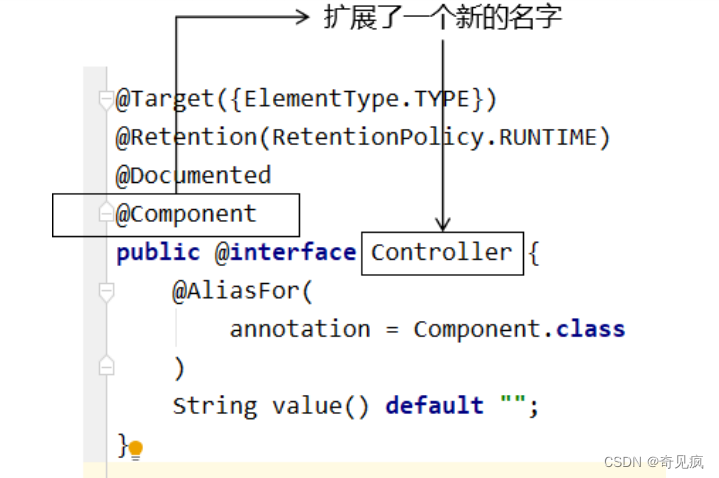
通过查看源码我们得知,@Controller、@Service、@Repository这三个注解只是在@Component注解的基础上起了三个新的名字。
对于Spring使用IOC容器管理这些组件来说没有区别。所以@Controller、@Service、@Repository这三个注解只是给开发人员看的,让我们能够便于分辨组件的作用。
注意:
- 虽然它们本质上一样,但是为了代码的可读性,为了程序结构严谨我们肯定不能随便胡乱标记。
比如
- @Controller用于controller层
- @Service用于service层
- @Repository用于dao(mapper)层
- @Component用于普通类
扫描组件
扫描注解需要引入 context 命名空间
情况一:最基本的扫描方式
<context:component-scan base-package="com.atguigu">
</context:component-scan>
情况二:指定要排除的组件
<context:component-scan base-package="com.atguigu">
<!-- context:exclude-filter标签:指定排除规则 -->
<!--
type:设置排除或包含的依据
type="annotation",根据注解排除,expression中设置要排除的注解的全类名
type="assignable",根据类型排除,expression中设置要排除的类型的全类名
-->
<context:exclude-filter type="annotation"
expression="org.springframework.stereotype.Controller"/>
<!--<context:exclude-filter type="assignable"
expression="com.atguigu.controller.UserController"/>-->
</context:component-scan>
情况三:仅扫描指定组件
<context:component-scan base-package="com.atguigu" use-default-filters="false">
<!-- context:include-filter标签:指定在原有扫描规则的基础上追加的规则 -->
<!-- use-default-filters属性:取值false表示关闭默认扫描规则 -->
<!-- 此时必须设置use-default-filters="false",因为默认规则即扫描指定包下所有类 -->
<!--
type:设置排除或包含的依据
type="annotation",根据注解排除,expression中设置要排除的注解的全类名
type="assignable",根据类型排除,expression中设置要排除的类型的全类名
-->
<context:include-filter type="annotation"
expression="org.springframework.stereotype.Controller"/>
<!--<context:include-filter type="assignable"
expression="com.atguigu.controller.UserController"/>-->
</context:component-scan>
使用注解后组件所对应的bean的id
- 在我们使用XML方式管理bean的时候,每个bean都有一个唯一标识,便于在其他地方引用。现在使用注解后,每个组件仍然应该有一个唯一标识。
默认情况
- 类名首字母小写就是bean的id。例如:UserController类对应的bean的id就是userController。
自定义bean的id
- 可通过标识组件的注解的value属性设置自定义的bean的id
如
@Service("userService")//默认为userServiceImpl
public class UserServiceImpl implements UserService {}
基于注解的自动装配
我们只用用 @Autowired注解 在成员变量上直接标记@Autowired注解即可完成自动装配,不需要提供setXxx()方法。以后我们在项目中的正式用法就是这样
@Autowired
private UserService userService;
其他细节
- @Autowired注解可以标记在构造器和set方法上
@Autowired注解的原理
-
默认通过 byType 的方式,在IOC容器中通过类型匹配某个 bean 为属性赋值
-
若有多个类型匹配的 bean ,此时会自动转换为 byName 的方式实现自动装配的效果,即将要赋值的属性的属性名作为 bean 的 id 匹配某个 bean 为属性赋值
-
若 byType 和 byName 的方式都无妨实现自动装配,即IOC容器中有多个类型匹配的 bean ,且这些 bean 的 id 和要赋值的属性的属性名都不一致,此时抛异常:NoUniqueBeanDefinitionException
-
此时可以在要赋值的属性上,添加一个注解@Qualifier
通过该注解的 value 属性值,指定某个bean的id,将这个bean为属性赋值
注意:
- 若IOC容器中没有任何一个类型匹配的bean,此时抛出异常:NoSuchBeanDefinitionException
@Autowired工作流程
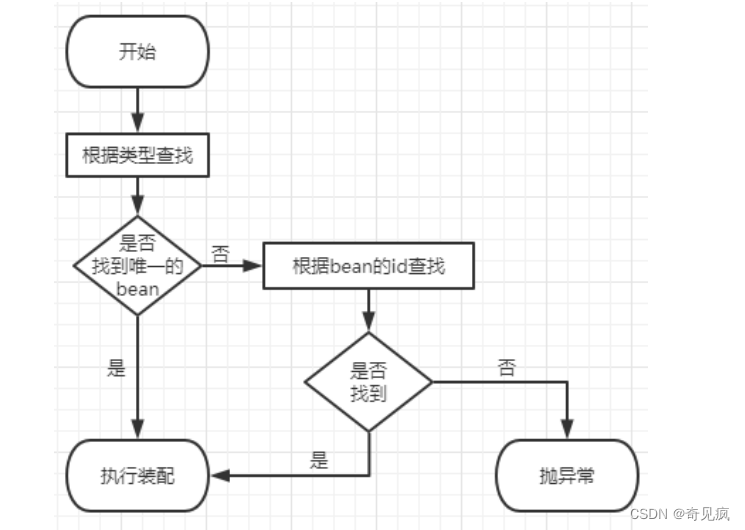
首先根据所需要的组件类型到IOC容器中查找
-
能够找到唯一的bean:直接执行装配
-
如果完全找不到匹配这个类型的bean:装配失败
-
和所需类型匹配的bean不止一个
- 没有@Qualifier注解:根据@Autowired标记位置成员变量的变量名作为bean的id进行匹配
-
能够找到:执行装配
-
找不到:装配失败
-
- 使用@Qualifier注解:根据@Qualifier注解中指定的名称作为bean的id进行匹配
-
能够找到:执行装配
-
找不到:装配失败
-
- 没有@Qualifier注解:根据@Autowired标记位置成员变量的变量名作为bean的id进行匹配
补充
-
@Autowired中有属性required,默认值为 true ,因此在自动装配无法找到相应的bean时,会装配失败
-
可以将属性required的值设置为 false ,则表示能装就装,装不上就不装,此时自动装配的属性为默认值
-
但是实际开发时,基本上所有需要装配组件的地方都是必须装配的,用不上这个属性。
AOP
在接触 AOP 前,我们需要了解代理模式
代理模式
介绍
- 二十三种设计模式中的一种,属于结构型模式。它的作用就是通过提供一个代理类,让我们在调用目标方法的时候,不再是直接对目标方法进行调用,而是通过代理类间接调用。让不属于目标方法核心逻辑的代码从目标方法中剥离出来——解耦。调用目标方法时先调用代理对象的方法,减少对目标方法的调用和打扰,同时让附加功能能够集中在一起也有利于统一维护。
使用代理前

使用代理后
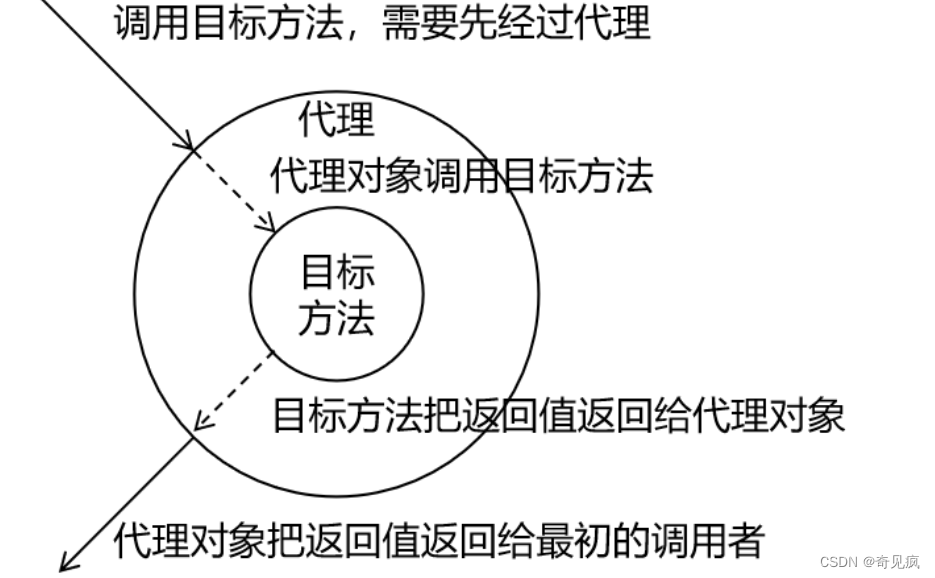
生活中的代理
-
广告商找大明星拍广告需要经过经纪人
-
合作伙伴找大老板谈合作要约见面时间需要经过秘书
-
房产中介是买卖双方的代理
相关术语
-
代理:将非核心逻辑剥离出来以后,封装这些非核心逻辑的类、对象、方法。
-
目标:被代理“套用”了非核心逻辑代码的类、对象、方法。
关于代理我之前提到过,这里就不赘述了
AOP概念及相关术语
概述
-
AOP(Aspect Oriented Programming)是一种设计思想,是软件设计领域中的面向切面编程。
-
它是面向对象编程的一种补充和完善。
-
它以通过预编译方式和运行期动态代理方式实现在不修改源代码的情况下给程序动态统一添加额外功能的一种技术。
相关术语
①横切关注点
-
从每个方法中抽取出来的同一类非核心业务。在同一个项目中,我们可以使用多个横切关注点对相关方法进行多个不同方面的增强。
-
这个概念不是语法层面天然存在的,而是根据附加功能的逻辑上的需要:有十个附加功能,就有十个横切关注点。
②通知
每一个横切关注点上要做的事情都需要写一个方法来实现,这样的方法就叫通知方法。
-
前置通知:在被代理的目标方法前执行
-
返回通知:在被代理的目标方法成功结束后执行(寿终正寝)
-
异常通知:在被代理的目标方法异常结束后执行(死于非命)
-
后置通知:在被代理的目标方法最终结束后执行(盖棺定论)
-
环绕通知:使用try…catch…finally结构围绕整个被代理的目标方法,包括上面四种通知对应的所有位置
③切面
- 封装通知方法的类。
④目标
- 被代理的目标对象。
⑤代理
- 向目标对象应用通知之后创建的代理对象。
⑥连接点
-
这也是一个纯逻辑概念,不是语法定义的。
-
把方法排成一排,每一个横切位置看成x轴方向,把方法从上到下执行的顺序看成y轴,x轴和y轴的交叉点就是连接点。
连接点可以理解为是横切关注点所在的位置
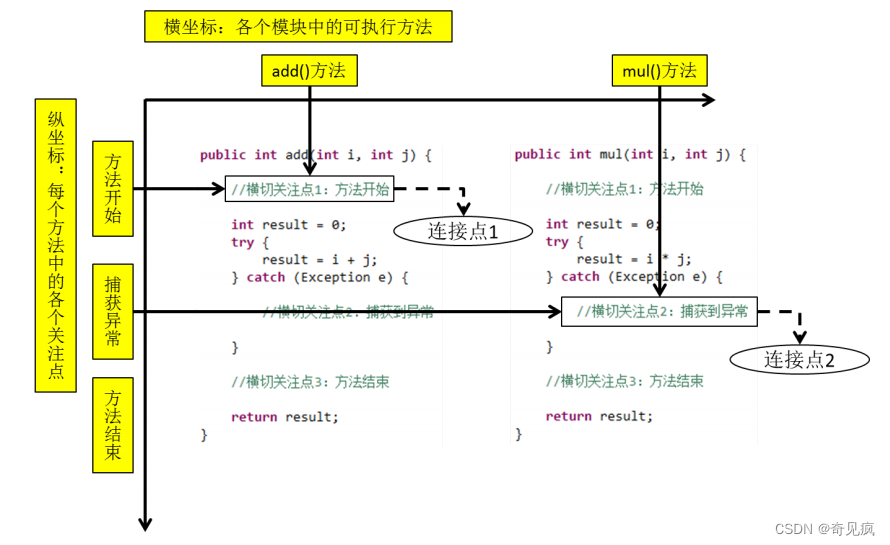
⑦切入点
-
定位连接点的方式。
-
每个类的方法中都包含多个连接点,所以连接点是类中客观存在的事物(从逻辑上来说)。
-
如果把连接点看作数据库中的记录,那么切入点就是查询记录的 SQL 语句。
-
Spring 的 AOP 技术可以通过切入点定位到特定的连接点。
-
切点通过 org.springframework.aop.Pointcut 接口进行描述,它使用类和方法作为连接点的查询条件。
作用
-
简化代码:把方法中固定位置的重复的代码抽取出来,让被抽取的方法更专注于自己的核心功能,提高内聚性。
-
代码增强:把特定的功能封装到切面类中,看哪里有需要,就往上套,被套用了切面逻辑的方法就被切面给增强了。
基于注解的AOP
技术说明

动态代理(InvocationHandler):JDK原生的实现方式,需要被代理的目标类必须实现接口。因为这个技术要求代理对象和目标对象实现同样的接口(兄弟两个拜把子模式)。
cglib:通过继承被代理的目标类(认干爹模式)实现代理,所以不需要目标类实现接口。
AspectJ:本质上是静态代理,将代理逻辑“织入”被代理的目标类编译得到的字节码文件,所以最终效果是动态的。weaver 就是织入器。Spring只是借用了 AspectJ 中的注解。
准备工作
①添加依赖
在IOC所需依赖基础上再加入下面依赖即可:
<!-- spring-aspects会帮我们传递过来aspectjweaver -->
<dependency>
<groupId>org.springframework</groupId>
<artifactId>spring-aspects</artifactId>
<version>5.3.1</version>
</dependency>
②准备被代理的目标资源
接口:
public interface Calculator {
int add(int i, int j);
int sub(int i, int j);
int mul(int i, int j);
int div(int i, int j);
}
实现类:
@Component
public class CalculatorPureImpl implements Calculator {
@Override
public int add(int i, int j) {
int result = i + j;
System.out.println("方法内部 result = " + result);
return result;
}
@Override
public int sub(int i, int j) {
int result = i - j;
System.out.println("方法内部 result = " + result);
return result;
}
@Override
public int mul(int i, int j) {
int result = i * j;
System.out.println("方法内部 result = " + result);
return result;
}
@Override
public int div(int i, int j) {
int result = i / j;
System.out.println("方法内部 result = " + result);
return result;
}
}
创建切面类并配置
// @Aspect表示这个类是一个切面类
@Aspect
// @Component注解保证这个切面类能够放入IOC容器
@Component
public class LogAspect {
@Before("execution(public int com.atguigu.aop.annotation.CalculatorImpl.*(..))")
public void beforeMethod(JoinPoint joinPoint){
String methodName = joinPoint.getSignature().getName();
String args = Arrays.toString(joinPoint.getArgs());
System.out.println("Logger-->前置通知,方法名:"+methodName+",参
数:"+args);
}
@After("execution(* com.atguigu.aop.annotation.CalculatorImpl.*(..))")
public void afterMethod(JoinPoint joinPoint){
String methodName = joinPoint.getSignature().getName();
System.out.println("Logger-->后置通知,方法名:"+methodName);
}
@AfterReturning(value = "execution(*com.atguigu.aop.annotation.CalculatorImpl.*(..))", returning = "result")
public void afterReturningMethod(JoinPoint joinPoint, Object result){
String methodName = joinPoint.getSignature().getName();
System.out.println("Logger-->返回通知,方法名:"+methodName+",结
果:"+result);
}
@AfterThrowing(value = "execution(*com.atguigu.aop.annotation.CalculatorImpl.*(..))", throwing = "ex")
public void afterThrowingMethod(JoinPoint joinPoint, Throwable ex){
String methodName = joinPoint.getSignature().getName();
System.out.println("Logger-->异常通知,方法名:"+methodName+",异常:"+ex);
}
@Around("execution(* com.atguigu.aop.annotation.CalculatorImpl.*(..))")
public Object aroundMethod(ProceedingJoinPoint joinPoint){
String methodName = joinPoint.getSignature().getName();
String args = Arrays.toString(joinPoint.getArgs());
Object result = null;
try {
System.out.println("环绕通知-->目标对象方法执行之前");
//目标对象(连接点)方法的执行
result = joinPoint.proceed();
System.out.println("环绕通知-->目标对象方法返回值之后");
} catch (Throwable throwable) {
throwable.printStackTrace();
System.out.println("环绕通知-->目标对象方法出现异常时");
} finally {
System.out.println("环绕通知-->目标对象方法执行完毕");
}
return result;
}
}
在Spring的配置文件中配置:
<!--
AOP的注意事项:
切面类和目标类都需要交给IOC容器管理
切面类必须通过@Aspect注解标识为一个切面
在Spring的配置文件中设置<aop:aspectj-autoproxy />开启基于注解的AOP(开启AspectJ的自动代理)
-->
<context:component-scan base-package="com.atguigu.aop.annotation">
</context:component-scan>
<!--开启基于注解的AOP-->
<aop:aspectj-autoproxy />
各种通知
-
前置通知:使用@Before注解标识,在被代理的目标方法前执行
-
返回通知:使用@AfterReturning注解标识,在被代理的目标方法成功结束后执行(寿终正寝)
-
异常通知:使用@AfterThrowing注解标识,在被代理的目标方法异常结束后执行(死于非命)
-
后置通知:使用@After注解标识,在被代理的目标方法最终结束后执行(盖棺定论)
-
环绕通知:使用@Around注解标识,使用try…catch…finally结构围绕整个被代理的目标方法,包括上面四种通知对应的所有位置
各种通知的执行顺序:
-
Spring版本5.3.x以前:
- 前置通知
- 目标操作
- 后置通知
- 返回通知或异常通知
-
Spring版本5.3.x以后:
- 前置通知
- 目标操作
- 返回通知或异常通知
- 后置通知
切入点表达式语法
①作用
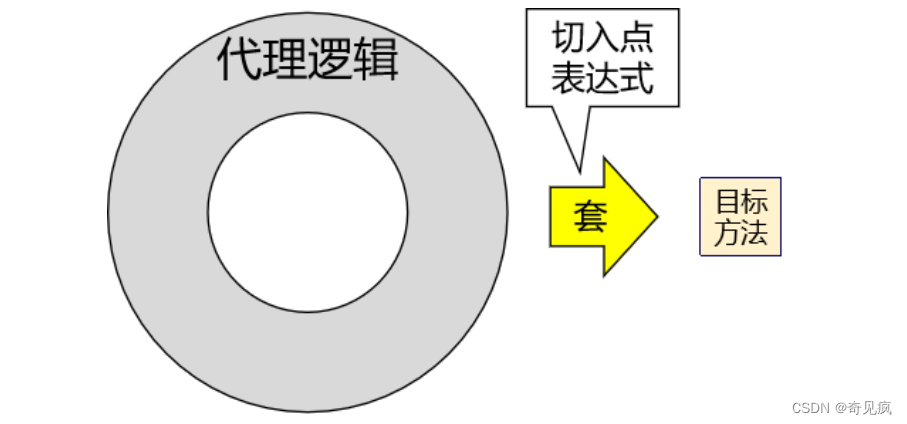
②语法细节
-
用 * 号代替“权限修饰符”和“返回值”部分表示“权限修饰符”和“返回值”不限
-
在包名的部分,一个“ * ”号只能代表包的层次结构中的一层,表示这一层是任意的。
- 例如:* .Hello匹配com.Hello,不匹配com.atguigu.Hello
-
在包名的部分,使用“ * . . ”表示包名任意、包的层次深度任意
-
在类名的部分,类名部分整体用 * 号代替,表示类名任意
-
在类名的部分,可以使用 * 号代替类名的一部分
- 例如: * Service匹配所有名称以Service结尾的类或接口
-
在方法名部分,可以使用 * 号表示方法名任意
-
在方法名部分,可以使用 * 号代替方法名的一部分
- 例如: * Operation匹配所有方法名以Operation结尾的方法
-
在方法参数列表部分,使用(. .)表示参数列表任意
-
在方法参数列表部分,使用(int,. .)表示参数列表以一个int类型的参数开头
-
在方法参数列表部分,基本数据类型和对应的包装类型是不一样的
- 切入点表达式中使用 int 和实际方法中 Integer 是不匹配的
-
在方法返回值部分,如果想要明确指定一个返回值类型,那么必须同时写明权限修饰符
- 例如:execution(public int …Service. * (…, int)) 正确
- 例如:execution(* int …Service. * (…, int)) 错误

重用切入点表达式
①声明
@Pointcut("execution(* com.atguigu.aop.annotation.*.*(..))")
public void pointCut(){}
②在同一个切面中使用
@Before("pointCut()")
public void beforeMethod(JoinPoint joinPoint){
}
③在不同切面中使用
@Before("全类名.pointCut()")
public void beforeMethod(JoinPoint joinPoint){
}
获取通知的相关信息
①获取连接点信息
- 获取连接点信息可以在通知方法的参数位置设置JoinPoint类型的形参
@Before("execution(public int com.atguigu.aop.annotation.CalculatorImpl.*(..))")
public void beforeMethod(JoinPoint joinPoint){
//获取连接点的签名信息
String methodName = joinPoint.getSignature().getName();
//获取目标方法到的实参信息
String args = Arrays.toString(joinPoint.getArgs());
System.out.println("Logger-->前置通知,方法名:"+methodName+",参数:"+args);
}
②获取目标方法的返回值
- @AfterReturning中的属性returning,用来将通知方法的某个形参,接收目标方法的返回值
@AfterReturning(value = "execution(* com.atguigu.aop.annotation.CalculatorImpl.*
(..))", returning = "result")
public void afterReturningMethod(JoinPoint joinPoint, Object result){
String methodName = joinPoint.getSignature().getName();
System.out.println("Logger-->返回通知,方法名:"+methodName+",结果:"+result);
}
③获取目标方法的异常
- @AfterThrowing中的属性throwing,用来将通知方法的某个形参,接收目标方法的异常
@AfterThrowing(value = "execution(* com.atguigu.aop.annotation.CalculatorImpl.*
(..))", throwing = "ex")
public void afterThrowingMethod(JoinPoint joinPoint, Throwable ex){
String methodName = joinPoint.getSignature().getName();
System.out.println("Logger-->异常通知,方法名:"+methodName+",异常:"+ex);
}
@Around("execution(* com.atguigu.aop.annotation.CalculatorImpl.*(..))")
public Object aroundMethod(ProceedingJoinPoint joinPoint){
String methodName = joinPoint.getSignature().getName();
String args = Arrays.toString(joinPoint.getArgs());
Object result = null;
try {
System.out.println("环绕通知-->目标对象方法执行之前");
//目标方法的执行,目标方法的返回值一定要返回给外界调用者
result = joinPoint.proceed();
System.out.println("环绕通知-->目标对象方法返回值之后");
} catch (Throwable throwable) {
throwable.printStackTrace();
System.out.println("环绕通知-->目标对象方法出现异常时");
} finally {
System.out.println("环绕通知-->目标对象方法执行完毕");
}
return result;
}
切面的优先级
- 相同目标方法上同时存在多个切面时,切面的优先级控制切面的内外嵌套顺序。
-
优先级高的切面:外面
-
优先级低的切面:里面
-
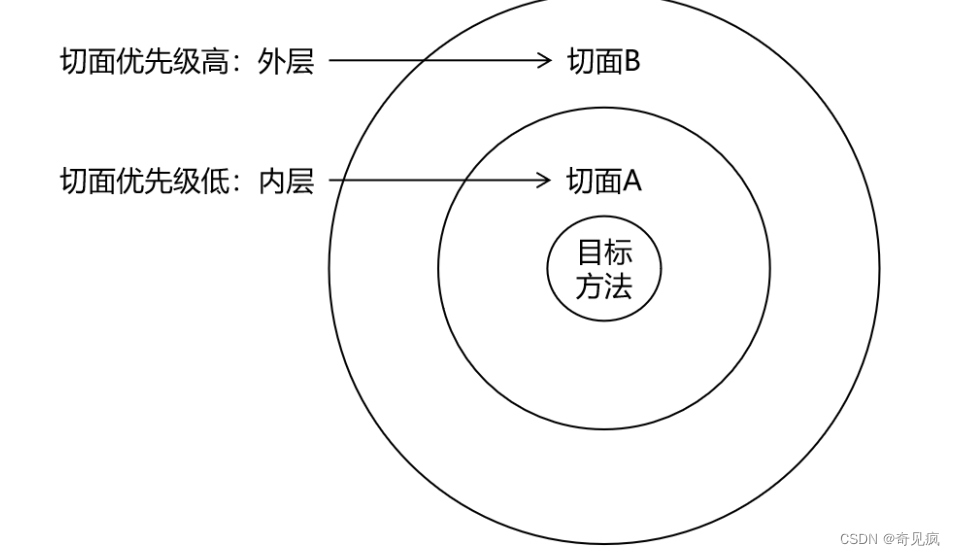
可以通过@Order注解的value属性设置优先级,默认值Integer的最大值
- @Order注解的value属性值越小,优先级越高
基于XML的AOP(了解)
准备工作
- 参考基于注解的AOP环境
实现
<context:component-scan base-package="com.atguigu.aop.xml"></context:componentscan>
<aop:config>
<!--配置切面类-->
<aop:aspect ref="loggerAspect">
<aop:pointcut id="pointCut" expression="execution(*
com.atguigu.aop.xml.CalculatorImpl.*(..))"/>
<aop:before method="beforeMethod" pointcut-ref="pointCut"></aop:before>
<aop:after method="afterMethod" pointcut-ref="pointCut"></aop:after>
<aop:after-returning method="afterReturningMethod" returning="result"
pointcut-ref="pointCut"></aop:after-returning>
<aop:after-throwing method="afterThrowingMethod" throwing="ex" pointcutref="pointCut"></aop:after-throwing>
<aop:around method="aroundMethod" pointcut-ref="pointCut"></aop:around>
</aop:aspect>
<aop:aspect ref="validateAspect" order="1">
<aop:before method="validateBeforeMethod" pointcut-ref="pointCut"></aop:before>
</aop:aspect>
</aop:config>





















 661
661











 被折叠的 条评论
为什么被折叠?
被折叠的 条评论
为什么被折叠?








